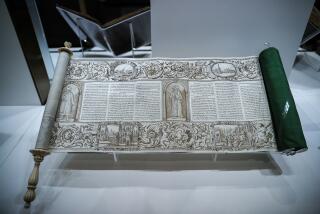Drawing on the truth to expose the lie
“The Protocols of the Elders of Zion” is perhaps the only book that has ever had the perverse distinction of being both widely influential and, at the same time, a complete forgery. The fact is, Jewish leaders and bankers never did meet in secret and plot to take over the world. Of course, it was not a love of history that brought so many readers to its pages. “The Protocols” is one of those lingering lies that endure despite all efforts to expose them. The very existence of the book has a way of giving censorship a good name and forcing free-speech absolutists to reconsider their core values.
Will Eisner, the legendary pioneer of the graphic novel who died this year, spent two decades studying the historical hatred of Jews and how this ultimately led to the pernicious authorship of “The Protocols.” In his outstanding final work, “The Plot: The Secret Story of the Protocols of the Elders of Zion,” Eisner may not have had the final word, but he may very well have produced the ultimate illustration of how absurdly comical and cancerous “The Protocols” has been to mankind.
“The Plot” is revealed in chronological order, like a history book, a primer on anti-Semitism, with various major characters of the 20th century, including Hitler and Henry Ford -- and even Eisner himself -- given walk-on roles in this tale of political manipulation, seething prejudice and self-interest. Although it was first widely disseminated in Russia in 1905, its origins are actually in the France of Napoleon III. In 1864, Maurice Joly, a lawyer and political essayist critical of the emperor, wrote a satirical book, “Dialogue in Hell Between Machiavelli and Montesquieu,” which was intended to draw a symbolic connection between the emperor of France and the power-mad author of “The Prince.”
Jews weren’t the subject of this book. All Joly wanted to achieve was to link Napoleon III with Machiavelli in the minds of French readers. Of course, emperors have little tolerance for criticism. Joly was convicted of defamation and ended up committing suicide. Yet his book didn’t die with him. This otherwise harmless allegorical novel was ultimately transformed into an even greater fiction, a book that would become the most damning and preposterous blood libel against world Jewry.
In 1905, Russian Czar Nicholas II, a man fearful of modernization and protective of his monarchy (given the impending communist revolution, he had reason to be), received a secret weapon from his secret police -- a piece of propaganda that would spread fear and suppress dissent. A Russian operative who was working in France, Mathieu Golovinski, had discovered Joly’s book and set out to copy it -- nearly word for word -- except he inserted a Jewish conspiracy at every turn.
Golovinski was a venal, marginal but ambitious man with many chips on his shoulders, yet skilled at fabricating evidence and forging documents. He was, in essence, the Watergate burglar of his day, willingly carrying out the czar’s dirty work, a bureaucrat who would become the chief architect and author of a book that supplied the narrative undercurrents for almost every anti-Semitic movement of the 20th century. As Eisner has one of Golovinski’s superiors advising him, “Our people will believe anything negative about the Jews! Go ahead, boy!”
But Golovinski’s concoction didn’t rely entirely on the “bait and switch” between Joly’s book and Jewish animus. Other factors made “The Protocols” both plausible and enticing. First, it is not as though Jewish leaders didn’t gather at a worldwide meeting that roughly coincided with the dates described in “The Protocols.” In 1897, in Basel, Switzerland, Theodor Herzl organized the First Zionist Congress, which called for the creation of a Jewish homeland. At issue, of course, was Jewish statehood, not Jewish world domination. But the fact that there was a meeting somehow gave credence to a conspiracy.
Similarly, France at the time was experiencing a wave of anti-Semitic fervor resulting from the Dreyfus affair. In 1894, Alfred Dreyfus, a captain in the French army, was falsely charged and convicted of treason for having allegedly supplied the Germans with confidential documents. The case against him was virtually nonexistent, other than that he was a Jew of Alsatian origin. Indeed, the evidence pointed to another officer. In 1906, after years of bitter national divisiveness over “l’affaire Dreyfus,” he was exonerated and reinstated into the military.
Yet the idea that Jews were traitors and were not to be trusted, that they were a people with aspirations to topple both governments and financial markets, was intellectually fashionable even if intellectually fabricated. Ironically, the French were more comfortable assuming a Jewish conspiracy than recognizing the French one. After all, the conspiracy in France was propagated by the government against Dreyfus, not the other way around.
The same was true of “The Protocols.” The conspiracy was manufactured not by Jews but by those who wished them harm. Yet it was this conspiracy that somehow, beyond all reason, became evidence of a Jewish conspiracy. Such is the twisted logic of scapegoating. Indeed, without minimizing Mel Gibson’s recent contribution to the cause, “The Protocols” has had a far greater anti-Semitic impact than all the Passion plays ever produced.
Eisner’s graceful, detailed drawings take readers to the hot spots around the world where “The Protocols” appeared. “The Plot” reads like a thriller about a disease that spreads out of control -- from its incubation to its first infection to the ferocity of its viral stamina. Apparently, no matter what you do, there is no cure for this epidemic. Eisner shows us newspaper articles and various editions of “The Protocols” adorned with caricatures possessing hooked noses and long, larcenous fingers actually hooked into the globe.
There is even a side-by-side comparison between “The Protocols” and Joly’s “Dialogue in Hell” to prove the extent of the transparent forgery. Golovinski may have been tricky, but he was also sloppy. He has the Elders of Zion praying to Vishnu, a Hindu god. And he forgot to change the interest rate that appeared in Joly’s novel as an example of crippling national debt.
The real hero of this tale is Philip Graves, a correspondent for the Times of London, who in 1921 exposed the falsity of “The Protocols” but naively assumed that the allure of its premises would wither in the minds of fair-minded people. As Graves’ editor obtusely reminds him in “The Plot,” “This fraud will soon be well known everywhere.... So, my boy, what harm can the ‘Protocols’ possibly do now?”
Yet by 1922 the book had been published in 16 languages and had sold half a million copies in America alone. It was quoted in “Mein Kampf,” and there were two separate French translations in 1934. In 1937, a Swiss court ruled that “The Protocols” was defamation; in 1964, a subcommittee of the U.S. Senate condemned “The Protocols” as a fake. Yet the book still sells in this country and is popular with Islamic extremists throughout the Middle East. And as recently as 1992 “The Protocols” was required reading for some Roman Catholic schoolchildren in Mexico, according to Eisner.
In his preface, Eisner remarks on the popularity of graphic narrative as a way to reach readers in a “more accessible language.” It is true that Eisner has written and illustrated an important and -- tragically, it seems, always -- timely book. Perhaps it is a reflection of our broader culture that, in the same way that the drawings of Art Spiegelman’s “Maus” have given readers a deeper awareness of the Holocaust, “The Protocols” will perhaps be better discredited by Eisner’s “The Plot.”
Of course, the cruel paradox of “The Protocols” is that although it is entirely false, it is apparently irresistible to those who must possess it -- the ultimate addiction for the anti-Semite. It has taken on the characteristics of the very lie it has propagated. Apparently it is “The Protocols” itself that is bent on world domination.
More to Read
Sign up for our Book Club newsletter
Get the latest news, events and more from the Los Angeles Times Book Club, and help us get L.A. reading and talking.
You may occasionally receive promotional content from the Los Angeles Times.






